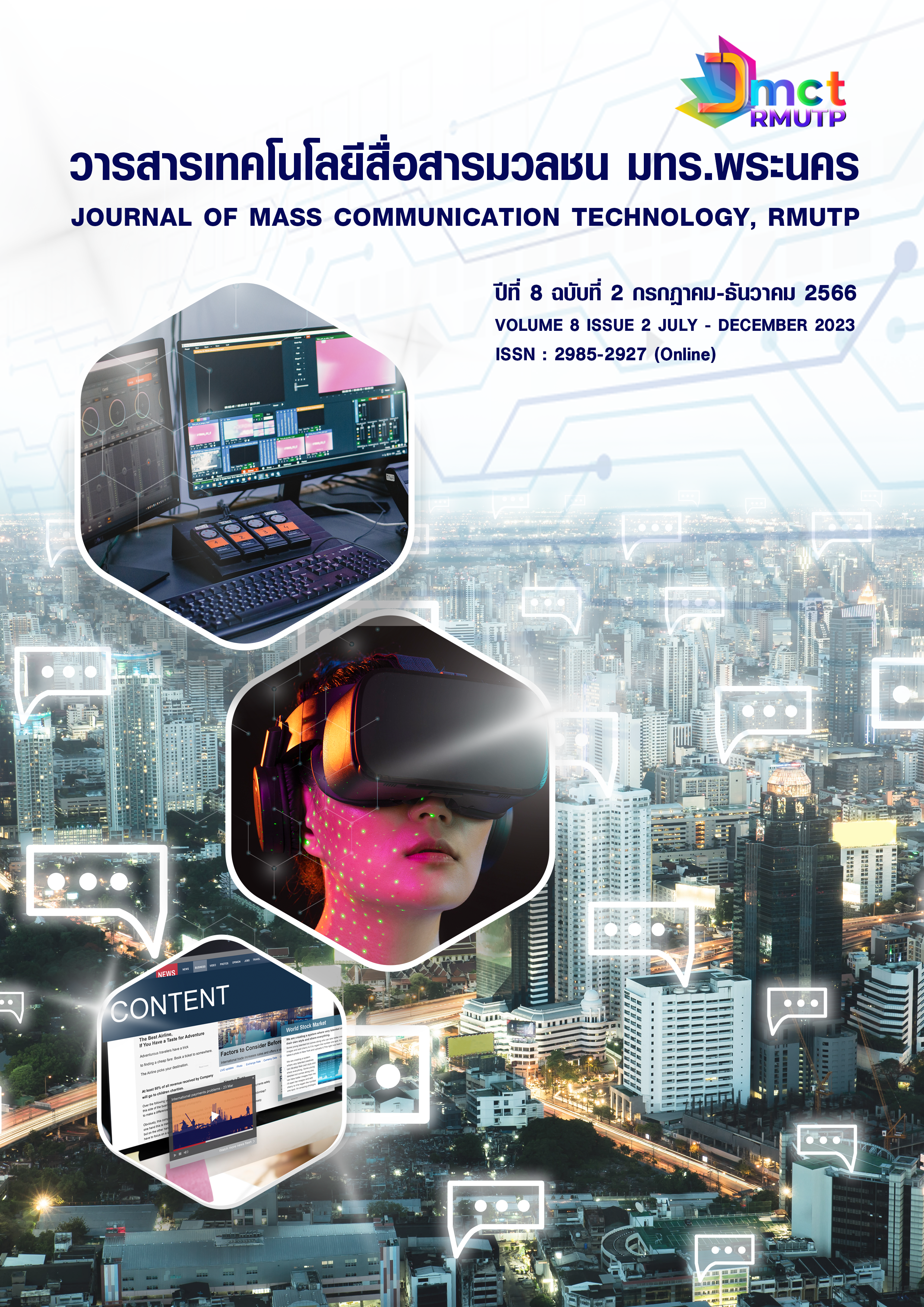การพัฒนาสื่อการเรียนรู้เทคโนโลยีความจริงเสริม ในรายวิชาภาษาไทย เรื่อง นิราศภูเขาทอง ของนักเรียนระดับชั้นมัธยมศึกษาปีที่ 1 โรงเรียนเซนต์คาเบรียล
คำสำคัญ:
สื่อการเรียนรู้, เทคโนโลยีความจริงเสริม, นิราศภูเขาทอง, รายวิชาภาษาไทยบทคัดย่อ
การวิจัยครั้งนี้มีวัตถุประสงค์เพื่อ 1) พัฒนาสื่อการเรียนรู้เทคโนโลยีความจริงเสริมในรายวิชาภาษาไทย เรื่องนิราศภูเขาทอง ให้มีคุณภาพเหมาะสมและมีประสิทธิภาพตามเกณฑ์ 80/80 2) ศึกษาผลสัมฤทธิ์ทางการเรียนของนักเรียนจากสื่อการเรียนรู้เทคโนโลยีความจริงเสริมในรายวิชาภาษาไทย เรื่องนิราศภูเขาทอง 3) ศึกษาดัชนีประสิทธิผลของสื่อการเรียนรู้เทคโนโลยีความจริงเสริม ในรายวิชาภาษาไทย เรื่องนิราศภูเขาทอง ของนักเรียนระดับชั้นมัธยมศึกษาปีที่ 1 และ 4) ศึกษาความพึงพอใจของนักเรียนที่มีต่อสื่อการเรียนรู้เทคโนโลยีความจริงเสริมในรายวิชาภาษาไทย เรื่องนิราศภูเขาทอง ของนักเรียนระดับชั้นมัธยมศึกษาปีที่ 1 กลุ่มตัวอย่าง คือ นักเรียนชั้นมัธยมศึกษาปีที่ 1 โรงเรียนเซนต์คาเบรียล จังหวัดกรุงเทพมหานคร ภาคเรียนที่ 1 ปีการศึกษา 2565 จำนวน 40 คน ซึ่งได้มาจากการสุ่มแบบยกกลุ่ม (Cluster Random Sampling) จำนวน 1 ห้องเรียน เครื่องมือที่ใช้ในการวิจัย ได้แก่ แผนการจัดการเรียนรู้ สื่อการเรียนรู้เทคโนโลยีความจริงเสริมแบบประเมินคุณภาพด้านเนื้อหาและสื่อ แบบทดสอบวัดผลสัมฤทธิ์ทางการเรียน และแบบสอบถามความพึงพอใจ สถิติที่ใช้ในการวิเคราะห์ข้อมูล ได้แก่ ค่าร้อยละ ค่าเฉลี่ย ค่าเบี่ยงเบนมาตรฐาน ค่า t-test และค่าดัชนีประสิทธิผล ผลการวิจัยพบว่า 1) สื่อการเรียนรู้เทคโนโลยีความจริงเสริมในรายวิชาภาษาไทย เรื่องนิราศภูเขาทอง ของนักเรียนระดับชั้นมัธยมศึกษาปีที่ 1 โรงเรียนเซนต์คาเบรียล มีคุณภาพด้านเนื้อหา และวัดประเมินผลอยู่ในระดับมากที่สุด (=4.67, S.D.=0.43) และด้านเทคนิคและวิธีการ มีคุณภาพอยู่ในระดับมากที่สุด (
=4.86, S.D.=0.16) ผลการหาดัชนีประสิทธิภาพเท่ากับ 80/97.50 ซึ่งสอดคล้องกับเกณฑ์ประสิทธิภาพ 80/80 เป็นเกณฑ์ที่กำหนดไว้ 2) คะแนนผลสัมฤทธิ์หลังเรียนของนักเรียน สูงกว่าคะแนนก่อนเรียนอย่างมีนัยสำคัญทางสถิติที่ระดับ .05 เป็นไปตามสมมติฐานที่ตั้งไว้ 3) ดัชนีประสิทธิผล (E.I.) ของสื่อการเรียนรู้เทคโนโลยีความจริงเสริมในรายวิชาภาษาไทย เรื่องนิราศภูเขาทอง มีค่าเท่ากับ 0.73 แสดงให้เห็นว่านักเรียนมีความรู้เพิ่มขึ้น คิดเป็นร้อยละ 73 และ 4) นักเรียนมีความพึงพอใจต่อสื่อการเรียนรู้เทคโนโลยีความจริงเสริมในรายวิชาภาษาไทย เรื่องนิราศภูเขาทอง โดยรวมอยู่ในระดับมากที่สุด (
=4.55, S.D.=0.59)
เอกสารอ้างอิง
จรินทร อุ่มไกร และไกยสิทธิ์ อภิระติง. (2562). การพัฒนาสื่อดิจิทัลร่วมกับเทคโนโลยีความจริงเสริมโดย อาศัยการเรียนรู้แบบร่วมมือด้วยเทคนิค STAD ในรายวิชาคอมพิวเตอร์ชั้นประถมศึกษาปีที่ 6. วารสารโครงงานวิทยาการคอมพิวเตอร์และเทคโนโลยีสารสนเทศ. 5(2), 18-27.
จิราภรณ์ ปกรณ์. (2561). AR (Augmented Reality) เทคโนโลยีโลกเสมือนผสานโลกแห่งความจริง. สืบค้นจาก URL: https://www.scimath.org/article-technology/item/7755-ar-augmented-eality.
ณัฐพล รำไพ. (2561). นวัตกรรมฉบับนักเทคโนโลยีการศึกษา. กรุงเทพมหานคร: วิสต้า อินเตอร์ปริ้นท์.
ปภัสรา ใจซื่อ. (2561). ระบบนิเวศดิจิทัลแบบปฏิสัมพันธ์ด้วยเทคโนโลยีความจริงเสริมพหุภาษาเพื่อส่งเสริมการเรียนรู้และการท่องเที่ยวเชิงวัฒนธรรม. วิทยานิพนธ์วิทยาศาสตรมหาบัณฑิต สาขาวิชาเทคโนโลยีสารสนเทศและการสื่อสารเพื่อการศึกษา คณะครุศาสตร์อุตสาหกรรม มหาวิทยาลัยเทคโนโลยีพระจอมเกล้าพระนครเหนือ.
เปรื่อง กุมุท. (2519). การวิจัยสื่อการสอนและนวัตกรรมทางการศึกษา. กรุงเทพมหานคร: มหาวิทยาลัยศรีนครินทรวิโรฒประสานมิตร.
เผชิญ กิจระการ. (2546). ดัชนีประสิทธิผล. [เอกสารที่ไม่ได้ตีพิมพ์]. ภาควิชาเทคโนโลยีการศึกษา คณะศึกษาศาสตร์ มหาวิทยาลัยมหาสารคาม.
พิษณุ จงเจริญ และณัฐพล รำไพ. (2564). การพัฒนาสื่อการเรียนรู้โดยใช้เทคโนโลยีความจริงเสริมในรายวิชาภาษาไทยพื้นฐาน เรื่อง ศิลาจารึกหลักที่ 1 เพื่อเสริมสร้างความสามารถในการเล่าเรื่องผ่านสื่อดิจิทัลของนักเรียนระดับชั้นมัธยมศึกษาปีที่ 2 โรงเรียนเซนต์คาเบรียล. วารสารเทคโนโลยีสื่อสารมวลชน มทร.พระนคร. 6(1), 41-52.
พันทิพา หนูซื่อตรง. (2560). ผลการเรียนด้วยหนังสือเรียนร่วมกับเทคโนโลยีความจริงเสริม และกระบวนการจัดการเรียนรู้แบบร่วมมือด้วยเทคนิคจิ๊กซอว์วิชาสังคมศึกษาศาสนาและวัฒนธรรม เพื่อส่งเสริมความสามารถในการแก้ปัญหาของนักเรียนชั้นมัธยมศึกษาปีที่ 1. วิทยานิพนธ์ศึกษาศาสตรมหาบัณฑิต สาขาวิชาเทคโนโลยีการศึกษา ภาควิชาเทคโนโลยีการศึกษา คณะศึกษาศาสตร์ มหาวิทยาลัยศิลปากร.
วีรภัทร จันทรจตุรภัทร. (2562). การพัฒนาสื่อการเรียนรู้โดยเทคนิค ความจริงเสมือน เรื่องแสงและเงา. วิทยานิพนธ์วิทยาศาสตรมหาบัณฑิต สาขาวิชาสื่อนฤมิต มหาวิทยาลัยมหาสารคาม.
สำนักงานเลขาธิการสภาการศึกษา. (2560). แผนการศึกษาแห่งชาติ พ.ศ. 2560 - 2579. สืบค้นจาก URL: https://www.stou.ac.th/Offices/Oaa/OaaOldPage/Professional/Train_Professional/oaaInfo/oaa/Dept/Dept04/webcur63/Rule_MUA/Plan_Inter2560-2579.pdf.
อดุลย์ วังศรีคูณ. (2557). การศึกษาไทยในศตวรรษที่21 ผลผลิตและแนวทางการพัฒนา. วารสารมนุษยศาสตร์และสังคมศาสตร์ บัณฑิตวิทยาลัย มหาวิทยาลัยราชภัฏพิบูลสงคราม. 8(1), 1-17.
Cagdas Erbas & Veysel Demirer. (2019). The Effects of Augmented Reality on Students' Academic Achievement and Motivation in a Biology Courset. Available from URL: https://onlinelibrary. wiley.com/doi/10.1111/jcal.12350.
R. K. Sari, et al. (2020). Augmented Reality as the Learning Media of Fundamental Chemistry on an Android Smartphone. Indoensia: Institut Agama Islam Negeri (IAIN).
Tasneem Khan, Kevin Johnston & Jacques Ophoff. (2019). The Impact of an Augmented Reality Application on Learning Motivation of Sudents. Available from URL: https://www.hindawi.com/journals/ ahci/2019/7208494/.

ดาวน์โหลด
เผยแพร่แล้ว
รูปแบบการอ้างอิง
ฉบับ
ประเภทบทความ
สัญญาอนุญาต
ลิขสิทธิ์ (c) 2023 วารสารเทคโนโลยีสื่อสารมวลชน มทร.พระนคร

อนุญาตภายใต้เงื่อนไข Creative Commons Attribution-NonCommercial-NoDerivatives 4.0 International License.
Copyright (c) วารสารเทคโนโลยีสื่อสารมวลชน มทร.พระนคร
วารสารเทคโนโลยีสื่อสารมวลชน มทร.พระนคร อยู่ภายใต้การอนุญาต Creative Commons Attribution-NonCommercial-NoDerivatives 4.0 International License. (CC BY-Nc-ND 4.0) เว้นแต่จะระบุไว้เป็นอย่างอื่น โปรดอ่านหน้านโยบายของเราสำหรับข้อมูลเพิ่มเติมเกี่ยวกับการเข้าถึงแบบปิด ลิขสิทธิ์ และการอนุญาต



